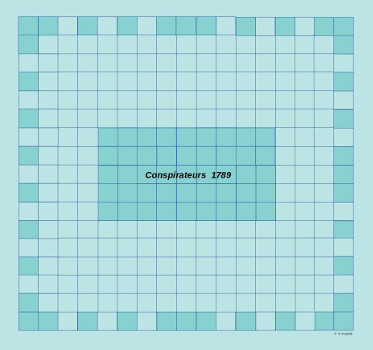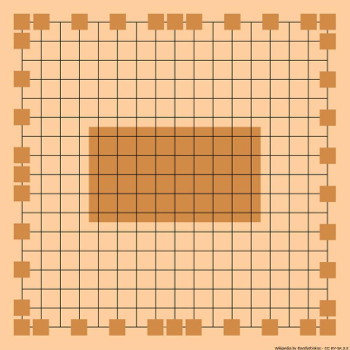Conspirators (or "Conspirateurs")
Written by Howard Fosdick © BestFreeNewGames.com
Overview: Conspirators dates from late 18th century France. Some say it was inspired by the conspirators behind the French Revolution. It's easy to learn but challenging and fun.
Players: For either 2 or 4 players.
Objective: Win the game by moving all your pieces from the centre rectangle into the safe houses at the edges of the board.

Set Up:
The board measures 17 by 17 squares. The secret meeting house is a 5 by 9 rectangle at the centre of the board. 39 safe houses are positioned around the edges of the board. These are represented by dark blue squares.
Two players each have 20 markers or "men" of their own colour. Four players use 10 men each.
Randomly decide who will take the first turn (alternate in subsequent games).
Play:
Play occurs in two phases.
In the Drop Phase, players alternate turns, each placing one of their men on any vacant square within the secret meeting house rectangle at the board's centre.
In the Movement Phase, players move one man per turn. Men move either horizontally, vertically, or diagonally one square.
Men can jump over either friendly or opponent men, as long as there is an immediately adjacent vacant space on the other side of the piece you jump (just as in Checkers). One man may make a string of connected jumps within a single turn. The man may alter direction during a series of jumps.
Jumping is not compulsory. Jumped pieces are not removed from the board.
Winning: First player to move each of his pieces to a safe house wins. Note that each safe house can only hold one man, and that there are only 39 safe houses while there are 40 markers in play.
Similar Games: Try several similar games for which we also provide rules and analysis: Chinese Checkers, Halma, Ugolki, Pyramid, and Salta.
Tips for Play: In a way, Conspirators is like a game of musical chairs. There are 40 plotters who need safe houses but only 39 are on offer. Will your man be left out, or your opponent's? The answer to that question determines who wins the game.
Conspirators requires moving your pieces as quickly as possible to the edges of the board. You do this most effectively by jumping over friendly and opposing pieces. The goal is to create optimal jumping sequences to move your men into winning position as quickly as possible. If you're clever you'll be able to leverage your opponent's pieces in the endeavour.
From a defensive standpoint, you want to disrupt your opponent's attempts to create or maintain jumping opportunities. Move a man into position at the proper time to destroy a multiple jump sequence.
At the start, all men are clustered in the centre. The challenge to jumping and creating jumping chains is that of opening up vacant squares to jump on to. As the game matures, the pieces spread out, heading for opposite sides of the board. Sometimes moving a pair of pieces together in leapfrog fashion can speed their journies.
The principles embodied in Conspirators are the same as those in Chinese Checkers and Halma. In all three games, the goal is to move your men from their starting locations to a set of prescribed winning positions. In Conspirators, you move your markers from the centre rectangle to safe spots round the board's edges, whereas in Chinese Checkers and Halma, the goal is to move your men from their starting positions across the board and into the starting positions of your opponent.
The mechanics of movement are the same in all three games. You develop jumping chains to move your men quickly to their terminal positions. You can jump your own and your opponent's pieces. No men are ever removed from the board.
One big difference: in Conspirators, all markers are moving in similar directions, from the centre to the board edges. In Chinese Checkers and Halma, opponents move their men in opposite directions. They try to occupy the starting positions of their opponent.
Another difference: Conspirators has a drop phase. In Chinese Checkers and Halma, starting positions are fixed. The fact that Conspirators lets contestants select their starting positions adds a layer of strategic interest to the game.
Click here for more free games on this website.
Playing on the Lines:
Instead of placing men on top of squares, you can alternatively play on the intersections of the lines. It doesn't change the game. The tan board shows how this looks. Click here for free printable boards for either style of play.

Sources & Credits:
The game appears in New Rules for Classic Games by Wayne R. Schmittberger, (Wiley: 1992). Also see this Wikipedia entry.
The tan board appears courtesy of Wikipedia By Ihardlythinkso -CC BY-SA 3.0.
License: Feel free to print, copy, and distribute these rules, so long as you retain this paragraph. Written by Howard Fosdick © 2023, distributed under Creative Commons License BY-ND. HOME